AMD Ryzen 5 3600 Review: Why Is This Amazon's Best Selling CPU?
by Dr. Ian Cutress on May 18, 2020 9:00 AM ESTCPU Performance: System Tests
Our System Test section focuses significantly on real-world testing, user experience, with a slight nod to throughput. In this section we cover application loading time, image processing, simple scientific physics, emulation, neural simulation, optimized compute, and 3D model development, with a combination of readily available and custom software. For some of these tests, the bigger suites such as PCMark do cover them (we publish those values in our office section), although multiple perspectives is always beneficial. In all our tests we will explain in-depth what is being tested, and how we are testing.
All of our benchmark results can also be found in our benchmark engine, Bench.
Application Load: GIMP 2.10.4
One of the most important aspects about user experience and workflow is how fast does a system respond. A good test of this is to see how long it takes for an application to load. Most applications these days, when on an SSD, load fairly instantly, however some office tools require asset pre-loading before being available. Most operating systems employ caching as well, so when certain software is loaded repeatedly (web browser, office tools), then can be initialized much quicker.
In our last suite, we tested how long it took to load a large PDF in Adobe Acrobat. Unfortunately this test was a nightmare to program for, and didn’t transfer over to Win10 RS3 easily. In the meantime we discovered an application that can automate this test, and we put it up against GIMP, a popular free open-source online photo editing tool, and the major alternative to Adobe Photoshop. We set it to load a large 50MB design template, and perform the load 10 times with 10 seconds in-between each. Due to caching, the first 3-5 results are often slower than the rest, and time to cache can be inconsistent, we take the average of the last five results to show CPU processing on cached loading.
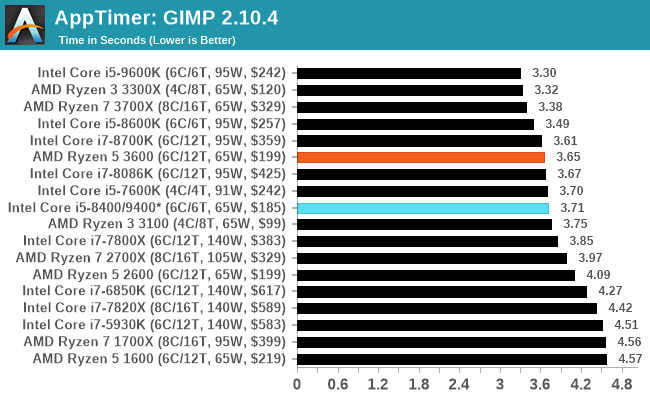
Not much difference here between the i5-8400 and the Ryzen 5 3600.
3D Particle Movement v2.1: Brownian Motion
Our 3DPM test is a custom built benchmark designed to simulate six different particle movement algorithms of points in a 3D space. The algorithms were developed as part of my PhD., and while ultimately perform best on a GPU, provide a good idea on how instruction streams are interpreted by different microarchitectures.
A key part of the algorithms is the random number generation – we use relatively fast generation which ends up implementing dependency chains in the code. The upgrade over the naïve first version of this code solved for false sharing in the caches, a major bottleneck. We are also looking at AVX2 and AVX512 versions of this benchmark for future reviews.
For this test, we run a stock particle set over the six algorithms for 20 seconds apiece, with 10 second pauses, and report the total rate of particle movement, in millions of operations (movements) per second. We have a non-AVX version and an AVX version, with the latter implementing AVX512 and AVX2 where possible.
3DPM v2.1 can be downloaded from our server: 3DPMv2.1.rar (13.0 MB)
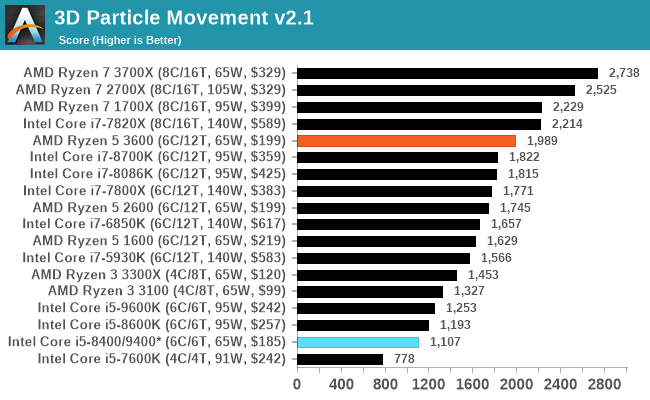
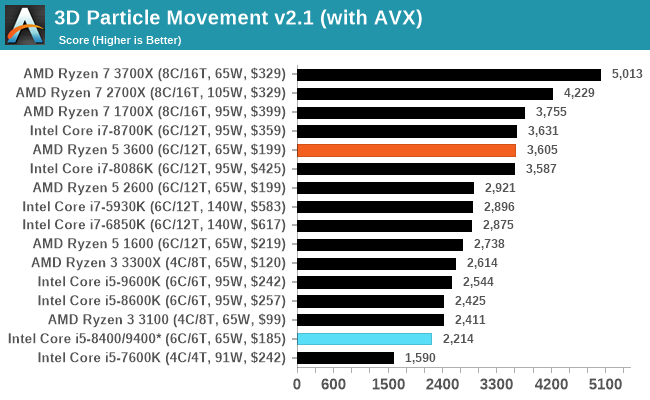
The core deficit comes on strong in 3DPM.
Dolphin 5.0: Console Emulation
One of the popular requested tests in our suite is to do with console emulation. Being able to pick up a game from an older system and run it as expected depends on the overhead of the emulator: it takes a significantly more powerful x86 system to be able to accurately emulate an older non-x86 console, especially if code for that console was made to abuse certain physical bugs in the hardware.
For our test, we use the popular Dolphin emulation software, and run a compute project through it to determine how close to a standard console system our processors can emulate. In this test, a Nintendo Wii would take around 1050 seconds.
The latest version of Dolphin can be downloaded from https://dolphin-emu.org/
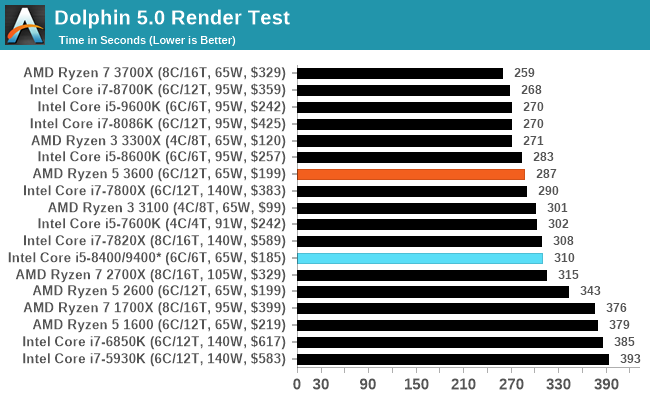
The Ryzen 5 3600 has better single threaded performance, and so the Dolphin emulation scores better with AMD.
DigiCortex 1.20: Sea Slug Brain Simulation
This benchmark was originally designed for simulation and visualization of neuron and synapse activity, as is commonly found in the brain. The software comes with a variety of benchmark modes, and we take the small benchmark which runs a 32k neuron / 1.8B synapse simulation, equivalent to a Sea Slug.
Example of a 2.1B neuron simulation
We report the results as the ability to simulate the data as a fraction of real-time, so anything above a ‘one’ is suitable for real-time work. Out of the two modes, a ‘non-firing’ mode which is DRAM heavy and a ‘firing’ mode which has CPU work, we choose the latter. Despite this, the benchmark is still affected by DRAM speed a fair amount.
DigiCortex can be downloaded from http://www.digicortex.net/
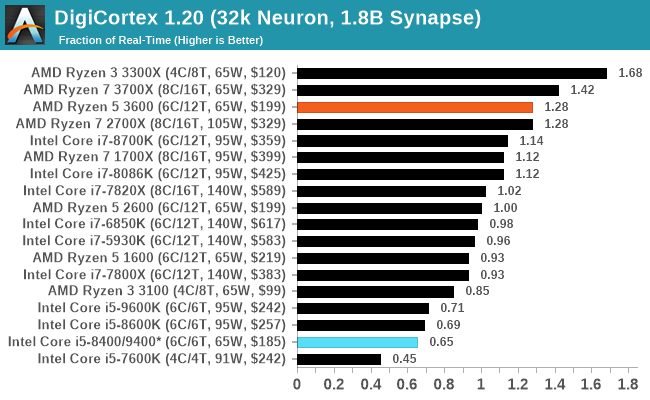
Dual DDR4-2666 doesn't mode well for the Intel processor.
y-Cruncher v0.7.6: Microarchitecture Optimized Compute
I’ve known about y-Cruncher for a while, as a tool to help compute various mathematical constants, but it wasn’t until I began talking with its developer, Alex Yee, a researcher from NWU and now software optimization developer, that I realized that he has optimized the software like crazy to get the best performance. Naturally, any simulation that can take 20+ days can benefit from a 1% performance increase! Alex started y-cruncher as a high-school project, but it is now at a state where Alex is keeping it up to date to take advantage of the latest instruction sets before they are even made available in hardware.
For our test we run y-cruncher v0.7.6 through all the different optimized variants of the binary, single threaded and multi-threaded, including the AVX-512 optimized binaries. The test is to calculate 250m digits of Pi, and we use the single threaded and multi-threaded versions of this test.
Users can download y-cruncher from Alex’s website: http://www.numberworld.org/y-cruncher/
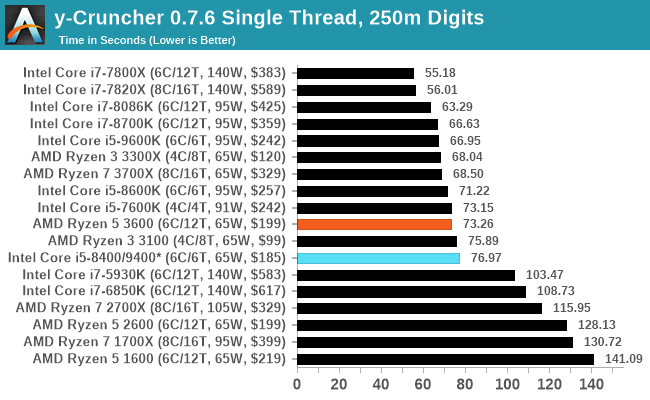

While almost similar in AVX2 in ST mode, the lack of threads again hurts the i5-8400, giving the win to the Ryzen 5 3600. Zen 2 does well here.
Agisoft Photoscan 1.3.3: 2D Image to 3D Model Conversion
One of the ISVs that we have worked with for a number of years is Agisoft, who develop software called PhotoScan that transforms a number of 2D images into a 3D model. This is an important tool in model development and archiving, and relies on a number of single threaded and multi-threaded algorithms to go from one side of the computation to the other.
In our test, we take v1.3.3 of the software with a good sized data set of 84 x 18 megapixel photos and push it through a reasonably fast variant of the algorithms, but is still more stringent than our 2017 test. We report the total time to complete the process.
Agisoft’s Photoscan website can be found here: http://www.agisoft.com/
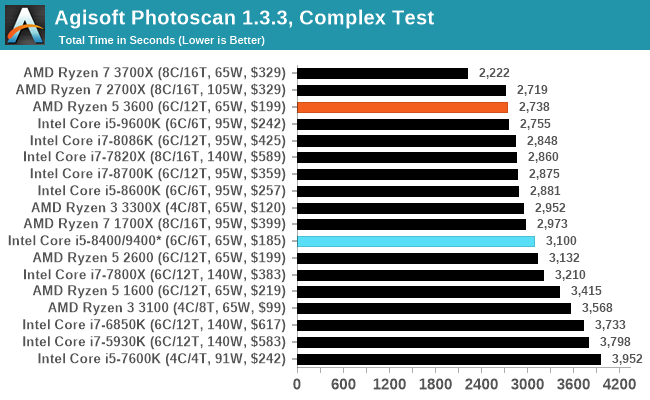












114 Comments
View All Comments
eastcoast_pete - Monday, May 18, 2020 - link
Thanks Ian!While this is not important for many (most?) readers here, I would like to see AMD or anyone else putting a more basic GPU (under $ 50 retail) out that has HDMI 2.0a or better, display port out, and that has ASICs for x264/265 and VP9 decoding; AV1 would be a plus. This could be a PCIe dGPU or something directly soldered into a MB. Am I the only one who's find that interesting? I don't like to always have to plug a high-powered dGPU into each build that has more than just an entry level CPU, so this would help.
Spunjji - Tuesday, May 19, 2020 - link
You'll likely be waiting a while. You'd need to wait for the next generation of GPUs with new display controllers and video decoders. There's a rumour that Nvidia will be producing an Ampere "MX550" for mobile, which could mean a dGPU based on the same chip being released for ~$100. Give that a couple more years to drop in price and, well, by then you'll probably want new standards. :DPgndu - Monday, May 18, 2020 - link
I come here for a clearer perspective more than benchmarks, but the timing of this article is weird, especially since 10th Gen's at the door. I get the market or Atleast pc builder cause and effect but market just got blown out of proportions with options, what actually transfers to general populace is not clear until OEM's embrace the reality like nividiaArbie - Monday, May 18, 2020 - link
"The Core i5-10500 ... is 65 W, the same as AMD".Anandtech knows very well that Intel TDP is not the same as AMD TDP. Please stop falling into the noob-journo trap of simply repeating the Intel BS just because it's official BS.
GreenReaper - Monday, May 18, 2020 - link
In fairness, TMD is also turboing to 88W, with cores plus uncore measured as taking significantly more than 65W.Spunjji - Tuesday, May 19, 2020 - link
Absolutely right, but also in fairness, Intel's sole enhancement for the 10 series appears to be enabling higher clock speeds - and they're made on the same process with the same architecture as the 9 series, which inevitably means more power will be required to reach those higher clocks.So, it's likely to be either a CPU with similar real power use to the AMD processor that never really hits its rated turbo clocks, or a CPU that does hit its rated turbo and never drops below ~100W under sustained load. It's likely to be power and speed competitive on an either/or basis, but not both at the same time.
watzupken - Tuesday, May 19, 2020 - link
This is true that its going above its TDP to provide the boost speed. However this is a practice that Intel has practiced since its Kaby Lake/ Coffee Lake series. Unfortunately, they are the worst violator when it comes to exceeding the supposed TDP when you consider how much power it is pulling to sustain its boost (PL2) speed. If you consider the boost speed of the Comet Lake, even the supposed 65W i5 10xxx series is not going to keep to 65W given the boost speed of up to 4.8Ghz, though nothing is mentioned about the all core turbo, but should be somewhere close, i.e. 4.2 to 4.6Ghz is my guess.lakedude - Monday, May 18, 2020 - link
I assume no one has mentioned the typo since it is still there."Competition
With six cores and twelve threads, the comparative Intel options vary between something like the Core i7-9600KF with six cores and no hyperthreading..."
Gotta be i5, right?
Kalelovil - Tuesday, May 19, 2020 - link
@Ian CutressThere appears to be a mistake in the AI Benchmark results, the Ryzen 5 3600 Combined result is less than the sum of its Inference and Training results.
xSneak - Tuesday, May 19, 2020 - link
Disappointed to see the continual cpu reviews using a GTX 1080 as the gpu. We would be better able to evaluate cpu performance if a 2080 ti was used given it is cpu bottlenecked at 1080p on some games. Hard to believe one of the biggest tech sites is using such under powered hardware.